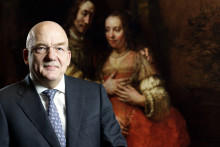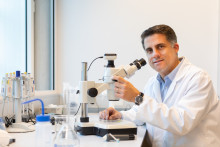Anton Schaaf, who is also a UT alumnus, has had a very successful career involving work at companies like Philips or Siemens. He is currently the CEO of Océ, a world´s leading enterprise in the field of printing and copying hardware, and therefore has a lot of insight into the high-tech industry. Schaaf was introduced by Victor van der Chijs, chairman of the event, who pointed out UT´s close collaboration with Océ.
Two sides of high-tech
‘High-tech environment is very motivating, because it forces you to learn new things all the time. It is very dynamic, but being dynamic has two sides to it,’ says Schaaf. During his career, Schaaf saw both sides of high-tech – the booms and the busts, as he says: ‘I worked on many things – such as military technology or telecom - that were literally booming at the time. Everybody wanted to be a part of it and make a lot of money very quickly, but you shouldn´t forget the downside of high-tech – every bubble bursts.’
Hypes and valleys of despair
We see it all the time. There are hypes full of buzz words (such as now very popular 3D printing) that create unrealistic expectations about the market possibilities. ‘When the hype is over, you suddenly have to face the reality and see what the market can really bring,’ thinks Schaaf. ‘Then you get to the valley of death, where companies often stay for many years.’
Jump and believe!
So what do you do when there is a paradigm shift? You jump! ‘You have to be a believer – believe in the new possibilities and products and jump to the new market,’ is convinced Schaaf. Even extremely successful technologies, including mobile phones, used to have many downsides in the beginnings. There is usually a very short window of opportunity, and so you have to act quickly and be willing to put everything on the line. ‘Do or do not. There is no try,’ quotes Schaaf.
Possibilities of printing
Anton Schaaf seems to know what he’s talking about, considering the company he’s leading is one of the biggest players on the market. Océ is a part of Canon group and has centers all around the world. For example, it develops large-scale printers that are used by Amazon to print books on demand. ‘Amazon books are shipped directly from their printing centers to their customers. That is highly efficient as one third of books used to be thrown away,’ explains Schaaf. ‘Even though you might not think so, printing industry is very large and there is a bigger demand for digital printing than ever before.’
To conclude, Schaaf says: ‘High-tech is a great place full of possibilities, but you should be aware of its dangers.’







